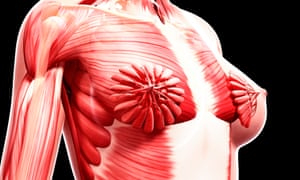How a viral image of breasts exposes science's obsession with the male body
An image of female anatomy has highlighted the far-reaching effects of treating the male of the species as the default
It has taken a viral tweet for thousands of people to realize that all human bodies are not male bodies – and that women’s muscular systems look different from men’s.
To be fair, the image, which displays milk ducts in all their raw, floral detail, is indeed a new one for many of our eyes (my own included). That isn’t out of personal ignorance, or at least not entirely. It’s also because American scientific and medical education – and, troublingly, research, treatment and standards – presume the male body is the default.
Artist formerly known as Byeonce(@lemonadead)
I just realized I never saw a photo of a female muscle system. This is NOT what I imagined milk ducts to look like. pic.twitter.com/GBK6trgXF8April 21, 2019
Just think about the images of skeletal, nervous and muscular systems you’ve seen before. Without skin (and a face) it’s not immediately obvious that you’re looking at a man. And yet it’s also clear that the default is a man. Even without milk ducts, the scientific images of human bodies that we typically see have male builds and musculature. Troublingly, we don’t even necessarily identify them as male and therefore specific only to half of the population. We see them as “normal”.
And that means female bodies are the abnormal other, even if, numerically, we make up more than half of the world’s population. This male default extends beyond the pictures we study in science class. It means that for more than a century, drugs have been primarily tested on men, their side-effects not well understood for women, who have different physical bodies and different hormones.
Dosing may be calculated by weight – assuming women who are two-thirds the size of men should take two-thirds of the dose – but that doesn’t actually account for how women’s bodies process drugs. Pregnant women are excluded from clinical trials, even though they may still use medications while pregnant – with no information on what it does to their bodies or their growing fetus. That can have deadly consequences.
When the male body is the default in biology classes, medical education and research, women get substandard care. And it goes deeper than that: defaulting to men in education is both a reflection and reinforcement of male defaults more generally. Men continue to dominate political, economic and public life more generally in part because their presence is normal and unquestioned. That’s not the case for women, who have to justify their entrance and see their presence questioned. Is this female politician likable enough? Is that female boss “difficult” or a Queen Bee? Are women funny?
This is the same reason we treat “women’s issues” like they are a special interest instead of the norm, and why questions like “should it be women or the government who controls a woman’s uterus?” are seriously debated in the political sphere – while no one debates a man’s right to choose Viagra.
It may seem like a stretch to say that we haven’t seen milk ducts for the same reason we haven’t had a female president. But it does come down to the same root: when only one sex is the default, the other becomes, well, the other.


沒有留言:
張貼留言